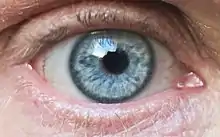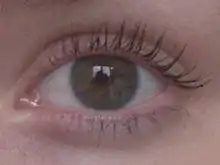Limbal ring
A limbal ring is a dark ring around the iris of the eye, where the sclera meets the cornea.[1] It is a dark-colored manifestation of the corneal limbus resulting from optical properties of the region.[2] The appearance and visibility of the limbal ring can be negatively affected by a variety of medical conditions concerning the peripheral cornea.[3] It has been suggested that limbal ring thickness may correlate with health or youthfulness and may contribute to facial attractiveness.[3][4] Some contact lenses are colored to simulate limbal rings.[1]

Youth, health, and attractiveness
Both health and age are positively correlated with a prominent limbal ring.[5] For instance, a darker limbal ring tends to be found more attractive than the absence of a limbal ring, suggesting that both sexes "use the limbal ring as a probabilistic indicator of reproductive fitness".[5] Furthermore, limbal rings appear to be most noticeable "for individuals relatively free from chronic health issues".[6]

The limbal ring is thought to contain corneal epithelium stem cells.[7] Diseases involving a limbal stem cell deficiency are associated with blindness, as those with such deficiencies are "unable to maintain a stable corneal surface.".[8] Transplantation of limbal stem cells is a promising therapy for limbal stem cell deficiency.[9]
See also
References
- Johnson and Johnson Vision Care Inc. Tinted contact lenses with combined limbal ring and iris patterns. US7246903B2. United States Patent and Trademark Office, July 24, 2007. http://patft.uspto.gov/netacgi/nph-Parser?Sect1=PTO1&Sect2=HITOFF&p=1&u=/netahtml/PTO/srchnum.html&r=1&f=G&l=50&d=PALL&s1=7246903.PN.
- Shyu, Betsy P.; Wyatt, Harry J. (2009). "Appearance of the Human Eye: Optical Contributions to the 'Limbal Ring'". Optometry and Vision Science. 86 (9): E1069–77. doi:10.1097/OPX.0b013e3181b4f010. PMID 19648842.
- Peshek, Semmaknejad, Hoffman, Foley (2011). "Preliminary evidence that the limbal ring influences facial attractiveness" (PDF). Evolutionary Psychology. 9 (2): 137–146. doi:10.1177/147470491100900201.CS1 maint: uses authors parameter (link)
- Brown M, Sacco DF (2018). "Put a (Limbal) Ring on It: Women Perceive Men's Limbal Rings as a Health Cue in Short-Term Mating Domains". Pers Soc Psychol Bull. 44 (1): 80–91. doi:10.1177/0146167217733072. PMID 28978250.
- Peshek, Semmaknejad, Hoffman, Foley (2011). "Preliminary evidence that the limbal ring influences facial attractiveness" (PDF). Evolutionary Psychology. 9 (2): 137–146. doi:10.1177/147470491100900201.CS1 maint: uses authors parameter (link)
- Brown M, Sacco DF (2018). "Put a (Limbal) Ring on It: Women Perceive Men's Limbal Rings as a Health Cue in Short-Term Mating Domains". Pers Soc Psychol Bull. 44 (1): 80–91. doi:10.1177/0146167217733072. PMID 28978250.
- Li, De-Quan; Chen, Zhuo; Song, Xiu Jun; de Paiva, Cintia S.; Kim, Hyun-Seung; Pflugfelder, Stephen C. (April 2005). "Partial enrichment of a population of human limbal epithelial cells with putative stem cell properties based on collagen type IV adhesiveness". Experimental Eye Research. 80 (4): 581–590. doi:10.1016/j.exer.2004.11.011. ISSN 0014-4835. PMC 2906384. PMID 15781286.
- James, S. Elizabeth; Rowe, Andrea; Ilari, Luca; Daya, Sheraz; Martin, Robin (July 2001). "The Potential for Eye Bank Limbal Rings to Generate Cultured Corneal Epithelial Allografts". Cornea. 20 (5): 488–494. doi:10.1097/00003226-200107000-00010. ISSN 0277-3740. PMID 11413404.
- Utheim, O. A.; Pasovic, L.; Raeder, S.; Eidet, J. R.; Fostad, I. G.; Sehic, A.; Roald, B.; Paz, M. F. de la; Lyberg, T.; Dartt, D. A.; Utheim, T. P. (2019-03-12). "Effects of explant size on epithelial outgrowth, thickness, stratification, ultrastructure and phenotype of cultured limbal epithelial cells". PLOS One. 14 (3): e0212524. Bibcode:2019PLoSO..1412524U. doi:10.1371/journal.pone.0212524. ISSN 1932-6203. PMC 6413940. PMID 30861002.
External links
| Wikimedia Commons has media related to Limbal rings. |